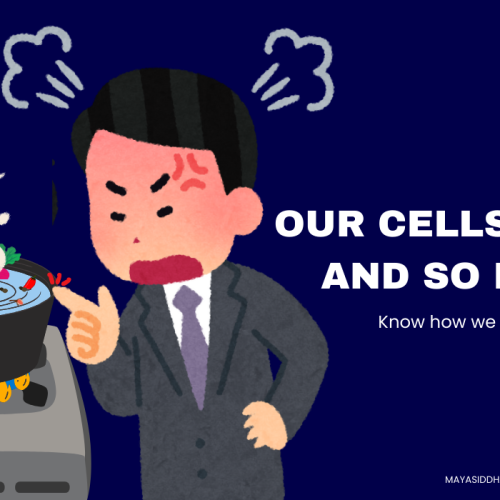Table of Contents
Introduction
Do you ever wonder why you feel the urge to sleep after a long period of being awake? Even if we try hard not to sleep, at some point we fall asleep. Have you ever thought why? In this blog, we gonna see how sleep pressure makes us sleep and wake.
Have you heard of sleep pressure? Yes, you have heard it right. Like how we are pressured to finish work within a given period, our body pressures us to sleep. Before knowing how sleep pressure makes us sleep, we need to understand the basics for easier understanding.
Homeostasis: Maintain balance
We know that our body does multiple functions throughout the day. Each function goes up and down like a see-saw as a response to the signals received from inside and outside the body.
Every function in our body has a normal range and limit level. When a function goes out of normal range, it may be either high or low or when reaches its limit level, our body automatically returns that function to its normal range.
So, our body functions as a response to the signals and also maintains a balanced state within our body. If it loses its balance, we will be diseased.
Sleep pressure
Now you know that our body maintains all the functions within the normal range. Let’s see how this formula applies to sleep pressure and how that pressure makes us sleep.
Sleep Pressure and sleep-wake Cycle
The bossy adenosine is the one that pressures us to sleep. Let’s see how it pressures us.
The Birth and Death of Adenosine
We know that we get energy from food, but how?
Our body converts the food into Adenosine triphosphate (ATP), the warehouse of energy. In a fancier way, Adenosine triphosphate signifies that adenosine is bonded with three phosphates. Since ATP is only a storage form of energy, energy is released when it breaks.

Sleep pressure
At last, adenosine is released when ATP breaks with all three phosphates to release energy and that energy is used by our cells to run the functions in our body.
As this breakup series runs in a cyclic pattern, the released adenosine again pairs with a phosphate to form AMP and the unused adenosine is excreted as waste from the body.
Where does this series take place?
This ATP to adenosine interconversion takes place inside and outside (Extracellular space) of each cell in our brain and body. And the level of adenosine inside and outside the cells remains balanced.
So, how does our body monitor the adenosine level?
Through receptors. Yes, you read it right. So, what is a receptor?
Receptors: Sensors and Receivers of the Cells
Receptors act as sensors and receivers. Every cell in our body has numerous receptors inside the cell and on the cell wall. They sense the changes inside and outside the cells and also receive messages from substances (like adenosine) and deliver them inside the cells.
Our cells modify some functions as a response to those changes and incoming messages.
When the adenosine goes out of normal range, receptors sense and signal the cells to bring back it to normal range. So, with the help of receptors, our body monitors adenosine levels to maintain a balanced state.
Sleep pressure and sleep
The longer we are awake, our body uses more energy and produces more adenosine. As our body is sensitive to changes this excessively produced adenosine puts our body under pressure, because homeostasis is disturbed.
To relieve the pressure, our body has to bring back adenosine to normal range, but it is quite difficult until we are awake, because more awake = more adenosine.
To relieve pressure it makes us sleep – Let me explain.
Our brain uses more energy than the rest of our body parts, which also means our brain produces more adenosine. The excess adenosine outside the cells in our brain decreases wakefulness and opens the door for sleep.
How?
This excess adenosine sticks to the adenosine receptor and signals the brain cells to slow down the activities. In other words, it reduces the brain’s activity and makes us relax by inducing sleep-promoting functions. But why does it choose to make us sleep?
Because in simpler words, sleep is the opposite of awake. So it becomes easier for our body to bring back adenosine to normal range when we sleep, as we are not awake.
That’s why this pressure caused by adenosine is called sleep pressure. This is why we feel the urge to sleep after being awake for a long period.

So, earlier we saw sleep maintains adenosine within the normal range. But do you know how our body does that process? Let’s see how it does.
Glymphatic system: Cleaning system of the brain
Our brain and spinal cord are surrounded by a fluid called CSF (Cerebrospinal fluid). Similarly, fluid found in the space between cells is ISF (Interstitial fluid). CSF and ISF together form the Glymphatic system, a cleaning system of the brain.
ISF contains extracellular wastes including unused adenosine and the wastes that are thrown from the inside of cells. These wastes from ISF are delivered to CSF during sleep.
| The CSF activity is 90% suppressed during the wake period and its activity is turned on during sleep. So the waste from the brain will be cleared only if we sleep. |
The CSF collects that waste and delivers it to another fluid system called the body’s Lymphatic system. CSF delivers brain waste to the lymphatic system in the neck and from there, it is delivered to the venous system of the heart for excretion from the body.
| Tips: Side sleeping regulates better glymphatic flow with more CSF clearance compared to back or stomach sleeping. |
- Send off Adenosine from the body
The adenosine that is not reused is converted into uric acid. This waste from the brain is cleared by the glymphatic system and is drained into the venous system via the lymphatic system of the body and eliminated by the kidneys through urine from our body.

| Tips: Exposure to sunlight for at least 15–30 minutes each day helps clear morning grogginess caused by adenosine residues after a good night’s sleep. |
Sleep pressure and wakefulness
During sleep, the adenosine level returns to the normal range, thus sleep pressure reduces and we are likely to wake, don’t we?
Answer: No, the duration it takes for adenosine to be cleared from the body is not the only factor influencing the length of our sleep. The sleep pressure and Circadian rhythm together determine our sleep-wake cycle.
Why do we go crazy when we don’t sleep?
Increased extracellular adenosine levels may disturb nerve functions. So, when we don’t sleep, we lose focus, deal with memory recollection, hallucinate and become emotionally unstable because these are all processed by our brain.
Summary
Our body maintains all its functions in a balanced state. When we are awake for a long period our body uses more energy and produces more adenosine. As our brain uses more energy than other parts of the body, more adenosine is produced in the brain. The excess adenosine outside the cells of the brain sticks to the adenosine receptor and reduces the brain’s activity and induces sleep.
During sleep, the brain’s waste-cleaning system, the Glymphatic system is activated which clears the unused adenosine and drops in the body’s venous system through the lymphatic system. The adenosine which has been converted into uric acid is eliminated in two ways – 2/3rd is eliminated by kidneys in the urine and 1/3rd is degraded in the intestine. In this way, the metabolic activity of the brain, that is, increased adenosine level makes us sleep and clears the waste while sleeping to maintain the balance.
Reference
1. Coddington, A. (1974). Inosine. Methods of Enzymatic Analysis (Second English Edition), 1932-1934. https://doi.org/10.1016/B978-0-12-091304-6.50053-7.
2. Boison, D. (2007). Adenosine Kinase. XPharm: The Comprehensive Pharmacology Reference, 1-8. https://doi.org/10.1016/B978-008055232-3.60527-6.
3. Vannoni, D., Bernini, A., Carlucci, F., Civitelli, S., Di Pietro, M. C., Leoncini, R., Rosi, F., Tabucchi, A., Tanzini, G., & Marinello, E. (2004). Enzyme activities controlling adenosine levels in normal and neoplastic tissues. Medical oncology (Northwood, London, England), 21(2), 187–195. https://doi.org/10.1385/MO:21:2:187.
4. Srinivasan, S., Torres, A. G., & Ribas de Pouplana, L. (2021). Inosine in Biology and Disease. Genes, 12(4), 600. https://doi.org/10.3390/genes12040600.
5. Silva-Vilches, C., Ring, S., & Mahnke, K. (2018). ATP and Its Metabolite Adenosine as Regulators of Dendritic Cell Activity. Frontiers in immunology, 9, 2581. https://doi.org/10.3389/fimmu.2018.02581.
6. Torday, J. S. (2015). Homeostasis as the Mechanism of Evolution. Biology, 4(3), 573-590. https://doi.org/10.3390/biology4030573.
7. Eltzschig, H. K. (2013). Extracellular Adenosine Signaling in Molecular Medicine. Journal of Molecular Medicine (Berlin, Germany), 91(2), 141- 146. https://doi.org/10.1007/s00109-013-0999-z.
8. Jessen, N. A., Finmann Munk, A. S., Lundgaard, I., & Nedergaard, M. (2015). The Glymphatic System – A Beginner’s Guide. Neurochemical Research, 40(12), 2583. https://doi.org/10.1007/s11064-015-1581-6.
9. Garcia-Gil, M., Camici, M., Allegrini, S., Pesi, R., & Tozzi, M. G. (2021). Metabolic Aspects of Adenosine Functions in the Brain. Frontiers in Pharmacology, 12. https://doi.org/10.3389/fphar.2021.672182.
10. Bjorness, T. E., & Greene, R. W. (2009). Adenosine and Sleep. Current Neuropharmacology, 7(3), 238-245. https://doi.org/10.2174/157015909789152182.
11. Torday, J. S. (2015). Homeostasis as the Mechanism of Evolution. Biology, 4(3), 573-590. https://doi.org/10.3390/biology4030573.
12. Artru, A. A. (2010). CEREBROSPINAL FLUID. Cottrell and Young’s Neuroanesthesia (FIFTH EDITION), 60-74. https://doi.org/10.1016/B978-0-323-05908-4.10008-9.
13. Reddy, O. C. (2020). The Sleeping Brain: Harnessing the Power of the Glymphatic System through Lifestyle Choices. Brain Sciences, 10(11). https://doi.org/10.3390/brainsci10110868.







